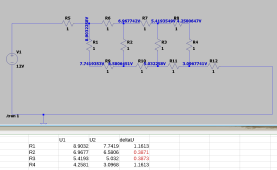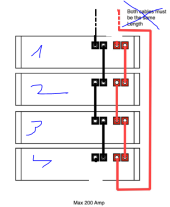@12VoltInstalls Hello,
When You use schematics, which I draw in my previous comment, it will work OK. But two middle batteries will be used with slightly less power due to ohmic law.
I have seen that phenomenon when I formated the LIFEPO Cells for my power plant. I used the same connection, but I used 16 cells. I have seen slightly less voltage on cells connected in middle of the wires.
I made some simulation on LTSPICE. I set every resistors to 1 Ohm for clear result (in reality impedance of battery or cells is many times higher, than wires).
Resistors R1,2,3,4 represent the BATTERY, other resistors is wires.
You can see the voltages measured in schematics.
Again: In reality this phenomenon exist, possible to measure. But it is not critical.
If you want to avoid that phenomenon, you must connect each battery with wire to common node with the exact same cable length.





